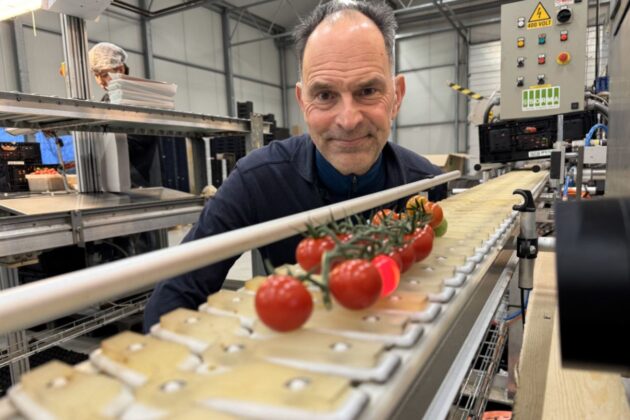Sensors can “see” if tomatoes are sweet enough

Consumers expect that deep red cherry tomatoes have a sweet and fresh taste, but this is not always the case. This leads to dissatisfied customers, who may choose another type of tomato next time.
This is a situation Wiig Gartneri wants to avoid. They produce Piccolo tomatoes, red cherry tomatoes that are extra sweet, and they know that the red colour is not a guarantee of sweetness. Now they want to use sensor technology to ensure that all the tomatoes they deliver to the stores taste just as sweet and fresh as the customers expect.
Random samples can give incorrect answers
The sweetness in tomatoes comes from the fruit sugar. Today, sweetness is measured through so-called Brix measurements. This is done by squeezing juice from the tomato and measuring the sugar concentration with an optical measuring instrument called a refractometer. This method destroys the tomatoes and can therefore only be used for spot checks.
“We have discovered that sometimes the reference method Brix works poorly, without fully understanding why. At the same time, we see that NIR measurements consistently work well. It was the analyses carried out by Nofima’s sensory assessors that made us discover that the Brix method can give deviating answers,” says Jens Petter Wold. He leads DigiFoods and is a senior scientist at Nofima.
A Piccolo tomato plant in a greenhouse lives for up to 12 months, and it takes 12-15 weeks from seed to the first red tomato. After three to six weeks, the sprout is moved to the greenhouse, and it takes about nine weeks before the first tomatoes are ready for harvest.
Taste tests confirm findings
In the work to develop calibrations that ensure that the NIR sensors measure the correct sugar content, the scientists have compared results from NIR sensors, Brix measurements, and Nofima’s sensory assessors panel.
The assessors panel consists of ten professional assessors, and they have analysed tomatoes that have undergone NIR measurements, and it turns out that the results are very consistent. The ten professional assessors at Nofima are a human instrument, and their measurements are far more nuanced than mechanical instruments. Their profession is to map and assess degrees of characteristics, preferably in food and drink.
Their analyses of Piccolo cherry tomatoes show that there are several flavours that follow the sweet tomatoes, like umami and acidic taste. In this context, acid gives freshness. The sweet tomatoes also had a more fruity smell. Conversely are the tomatoes with sour and green taste.
“It has been extremely useful to have the sensory panel involved in this research. Their results ensure that we can be confident that the sugar content we measure with NIR corresponds very well with sensory sweetness,” points out Jens Petter Wold.
The sugar in the tomato is evenly distributed
Another aspect the scientists have investigated is how the sweetness, i.e., the fruit sugar, is distributed in the tomatoes.
“We discovered that the sugar is evenly distributed in the tomatoes, and this is also of importance for how flexible Wiig can be in the choice of measuring instrument. When we know that the fruit sugar is fairly evenly distributed, we can also assume that it will work with measuring methods that do not measure as deeply into the tomatoes.” says Jens Petter Wold.
Testing sensors available on the market
The new NIR sensor developed by SINTEF and Nofima can measure well into a range of fruits and vegetables, and this provides good and stable measurements of sugar in tomatoes. But as of today, there is no commercial instrument available.
DigiFoods partner NEO is now developing and testing a solution based on their commercially available hyperspectral (HySpex) cameras to bridge this gap.
“NEO has successfully tested this solution on tomatoes, creating a dedicated setup for in-line quality grading that delivers promising results. The system was tested in reflectance mode with polarizers to enhance the measurement quality. Given the semi-transparent nature of tomatoes, this setup appears to penetrate deeply enough to obtain reliable measurements,” says Lars Gidskehaug, Solution Manager at NEO.
One advantage of hyperspectral imaging is that we can image the sugar content in each individual tomato, and this can be used to optimize quality selection and packaging of the tomatoes.
Measurements are made on the conveyor belt
When the tomato clusters are picked from the tomato plants in the greenhouse, they are placed on a conveyor belt. Today, the employees assess whether the tomatoes are good enough based on colour and remove the tomatoes they do not approve. These go to animal feed.
At the same time, we know that two tomatoes that look exactly the same can taste completely different. That is why Wiig wants a sensor to measure the sugar content in all the tomatoes. If some tomatoes do not have the sweet taste that customers want, these tomatoes are manually removed before the rest are moved to a cardboard cup.
How spectroscopy works
Spectroscopy is a technique that uses light to examine raw materials without destroying them. This is done by sending light towards or through the raw material and measuring how different wavelengths are absorbed. This provides information about the chemical composition.
NIR (near-infrared) spectroscopy sends light through a food item and can “see” a bit into the food item. Hyperspectral imaging is a type of spectroscopy that images the surface by taking pictures at many different wavelengths
Facts about the research
The development of the measurement methods and the quality assurance carried out by Nofima’s ten professional taste judges is done in the strategic research programmes Precision og Enable, which are funded by the Fund for Research Levy on Agricultural Products.
The NIR sensor tests are done in collaboration with SINTEF Digital and NEO and are part of SFI DigiFoods – Centre for Research-Driven Innovation. Funding by partners and The Research Council of Norway
You can read about this research and other results from Digifoods in the Annual Report – DigiFoods 2024.
Contact
Research areas
